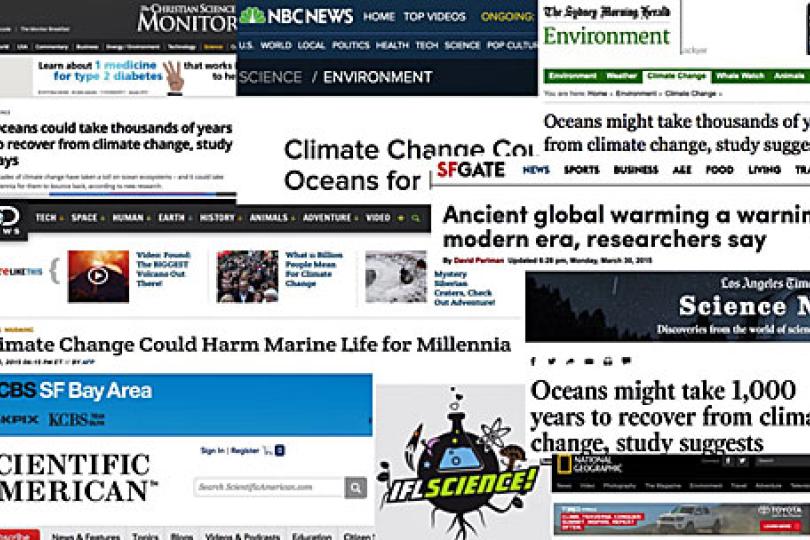Hey scientist! Are you ready to talk to the media...?
Editor's note: The following article originally appeared on Medium.com.
I’ve recently published two research papers on climate change in ocean systems, both with a significant media splash. On the other side of that experience, I have some hard-won perspective about what worked for me — and what I still need to practice.
For context: the published manuscripts can be found here and here. Both manuscripts are open access; go read them and share them with your friends. The PLOS ONE manuscript is a sort of meta-analysis of sediment cores from continental margins, which reconstructed the spatial extent and sensitivity of low oxygen subsurface oceanographic zones to abrupt climate warming. The PNAS manuscript is a marine biodiversity archive from one sediment core offshore of California, which demonstrated the extreme sensitivity of seafloor communities to abrupt climate warming and deoxygenation.
I’ve been thinking of these puzzle pieces over the last month — these individual steps that collectively made a framework for talking about science. Particularly, I’ve realized how badly some of the interviews couldhave gone if I hadn’t been prepared. The opportunity cost of doing a bad job at this was WAY HIGHER than I had initally thought. And, because what happens on the internet stays on the internet forever. So here is a listicle of communication steps that worked for me. I hope it’s helpful for other likewise anxious scientists.
1 — Take short courses on science communication. This is obvious. Basically, figure out how people who are smarter that you are thinking about science communication. Find access into an existing framework or body of knowledge — so that you can form your own opinions about science communication. Like many ocean and environmental scientists, I’ve taken some really great courses from COMPASS. A lot of the advice in this list is really just regurgitated from a COMPASS training, so you should just take their course. Additionally, what made the biggest impact for my on-my-toes communication skills was attending the William and Mitchell College of Law Expert Witness Training Academy (check out the link, there is a great video on the page for more information). Holy moly lawyers are WAY better at talking about everything than scientists. This course focuses on training scientists to communicate complex and technical ideas in adversarial settings.
2 — Get on the twitters. Seriously. Twitter is not cheap self promotion. It is a way to tap in — whenever and however suits you best — to a stream of information. Getting established on the twitters doesn’t mean that lots of people follow you. Rather, it means you follow the nodes of information in your field. Following your affiliated institutions, your colleagues, relevant NGOs, and journalists is the most direct way to get a rapid, diverse census of what is happening in the science media and broader conversation. Yes, this takes some time — but not that much. Ten minutes a day for a week will get you there.
3 — Connect with the communication office at your university or institution. Find the people who can help you get your message out. You may need to cold-email your communications office, or ask your colleagues for a introductory email. I worked with Kat Kerlin at UC Davis (@UCDavis_kerlin) — she was an amazing resource. Kat wrote the press releases that went out with both of the manuscripts, and was the first person outside our research team to advocate for the broad communication of our research findings. Talking with Kat led our research to be considered for broader promotion at the university level, and UC Davis filmed a short video on our research (see below).
4 — Fill out yer damn message box. I finally did this for the second manuscript. It made a difference. And when I tried to initially write it, the adolescent part of my brain said, “There are no benefits or solutions that you can take away from my research.” Yeah, right. It’s interesting how you can buck-pass, even in your own brain. The message box is actually a challenging and sophisticated way to get to the communication priorities of your science: easily dismissed, really hard to do. I posted my message box below — so you can see what I came up with.
5 — Factsheets: you need them. More than anything, I’ve needed to condense my 7 years of sprawling interior intellectual space into parsed, interesting take-home messages. Writing fact sheets for these two manuscripts forced me to condense my thinking and language into a short format (the fact sheets are here and here). And, when I needed to point a journalist to a resource about the manuscript, having the factsheet was awesome. In a vain and self-congratulatory way, I think it made me look professional and prepared, which goes a long way when you are interacting with busy, thinly-spread journalists.
6 — Be ready for the public and/or journalists to resonate with parts of your research that you hadn’t anticipated. This was an unexpected part of my experience. Particularly for the second manuscript, what we demonstrated (in a nut shell) was that a) seafloor communities are disturbed quickly, like decades to centuries, by climate warming and b) seafloor communities, and the coupled physical-biological system that they are a part of, can take thousands of year to recover after abrupt warming. Personally, I thought that take home point a was the eye-catching finding — wow, seafloor ecosystems are rapidly changed by abrupt climate warming. But almost all of the press focused on take home point b, with headlines like:Oceans might take 1,000 years to recover from climate change, from the LA times, or Climate change could harm marine life for millennia, from the Discovery Channel. The discrepancy showed me that I don’t understand and can’t anticipate popular science online culture.
7 — When your science goes “viral”, it’s a double-edged sword. By the time the PNAS manuscript reached I f*cking love science, I really came to terms with how out of my control the media response was. Maybe I hadn’t considered personally what “going viral” would feel like — but I’ll report back that it feels uncomfortable and gave my anxiety. It also showed me the vital importance of a clear and organized message from the very beginning. I didn’t have time to get better at talking about my science, because the time between when it went to press and when it went sort-of-viral (i.e. across international press and in most popular science media feeds) was basically a week. I don’t think you could do steps 1–7 in a week.
9 — Connect with your network of science communicators. Think about who you know that is successfully communicating science, and reach out to them. Ask them for help crafting a message, write a popular science piece and ask for feedback, or see if you can contribute as a guest poster to blogs that they are managing. This kind of active searching, for what essentially amounts to mentorship, led me to guest post at the Guardian’s 97% Climate Consensus blog: New research reveals extreme oxygen loss in oceans during past climate change. Cool.
9 — Develop a tough skin. After listening to myself, and watching myself walk on camera (THE WORST), I have felt the terror of knowing that I wasout there and definitely fodder for public criticism. It’s hard.
10 — Figure out what you want to say for the inevitable “so what”/bigger picture question. This part has to do with who you are, what your science means to you, and where you draw the lines between advocacy, objectivity and morality. This is not a simple consideration, although it might amount to as casual a sentence as, “I’m worried about climate change because I am a parent.” I am still working on this one, especially because I focus on issues that have to do with climate change and risks to our living planet. To put it mildly, there are major moral and ethical strings attached to these huge issues. And we have a 30 year history of abject climate communication failure, especially in the American media. The strategy of “sticking to the science” has not worked, and so I choose to both talk about the science and talk about what the science means to me and my family. That means there is a personal aspect to the narrative that I present with my science. I, personally, have a lot to lose in a future of unchecked climate warming. But my son has much, much more to lose. Being honest about this isn’t, to my mind, a sign of being biased. Rather, it’s part of the dignity of being a public servant, which is essentially my role as a climate scientist. This feels like uncharted and dangerous territory for me, especially as an untenured female academic. But it is what it is, and no one told me any of this would be easy.

